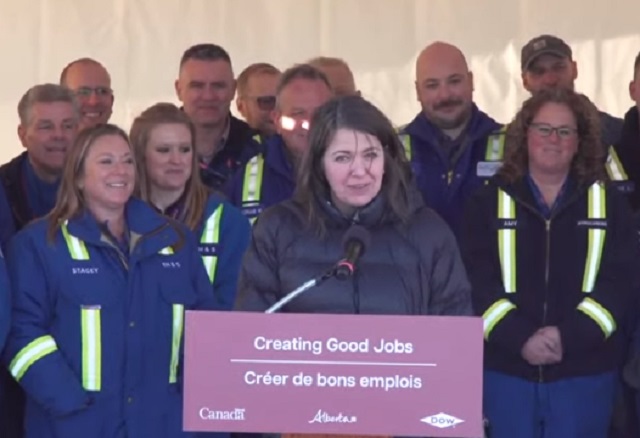Alberta
Multi-billion Dow Chemical investment pegs Alberta as a top spot for low carbon plastics production

The announcement Dow will construct the world’s first net-zero carbon emissions ethylene and derivatives complex, in Fort Saskatchewan, Wednesday November 29, 2023.
From the Canadian Energy Centre
By Will Gibson
Net zero petrochemical complex seen as a signpost for future investment in Alberta’s Industrial Heartland
Dow Chemical’s Nov. 28 announcement confirming it will invest $8.8 billion to build a net zero petrochemical complex near Edmonton was close to a decade in the making for Fort Saskatchewan Mayor Gale Katchur.
“Now that they’ve finally announced the project, I’m one of the happiest mayors around,” says Katchur, who was first elected in October 2010.
“What Dow is building will inspire other industries with innovation and technology like this. Dow has been a cornerstone for our community for the past 60 years. This investment ensures they are going to be around for a lot longer.”
The project, which has support from the municipal, provincial and federal governments, will increase Dow’s production of polyethylene, the most widely used plastic in the world.
Welcomed by the community
By capturing and storing carbon dioxide emissions and generating hydrogen on-site, the complex will be the world’s first ethylene cracker with net zero emissions from operations.
“I remember speaking to Dow executives during their regional visit some years back. They were curious about potential public concerns, given the visibility of their visit and the nature of their business,” Katchur says.
“My response was clear: the primary concern in our community is the pace of progress. People here recognize and appreciate the petrochemical industry. We understand the benefits that it brings.”
Competitive advantages
Katchur’s joy is shared by Mark Plamondon, executive director of Alberta’s Industrial Heartland Association, who sees the Michigan-based multinational’s decision as an endorsement of the region’s competitive advantages.
“Dow is a global company and could put their capital anywhere in the world,” says Plamondon, whose group attracts global investment in heavy industry to the 582-square-kilometre region northeast of Edmonton.
“What this demonstrates is Dow can meet both their economic and environmental goals by investing in this region. That sends a real message.”
Bob Masterson, CEO of the Chemistry Industry Association of Canada, sees Dow’s decision to build the facility as a signal of where the industry will make large investments in the future.
“In the short term, you are looking at the province’s largest construction project requiring more than 7,000 high-skill, high-paying jobs for the next seven to 10 years,” says Masterson, whose Ottawa-based group represents chemistry and plastics producers across Canada.
Alberta a top destination for low carbon chemical production
“What Dow’s decision really says is Alberta is a top destination for the chemistry industry to invest. One of the top chemical producers in the world is making this investment in Canada,” he says.
“When you look at the bigger picture, the only real rival for low-carbon investment of this kind is the U.S. Gulf Coast, where you have the same access to natural gas liquids as a feedstock and supportive public policy environment.”
The Industrial Heartland region is particularly attractive for companies looking to invest in low-carbon products, Masterson says.
“Alberta has an abundant low-carbon feedstock in natural gas liquids to produce hydrogen and the geological space to sequester carbon. These natural assets can encourage investment and support low-carbon chemistry industry,” he says.
“One of the largest petrochemical companies on the planet believes it can build a low-carbon chemistry plant based on these assets. Other companies will see they can generate and extract that value out of those resources in a very sustainable and responsible manner.”
Filling space on the Alberta Carbon Trunk Line
In addition to geological and natural resources, the region already possesses critical infrastructure to woo investment in low-carbon production, such as the Alberta Carbon Trunk Line (ACTL), the world’s largest CO2 pipeline.
Dow has signed an agreement with ACTL owner Wolf Midstream to utilize space on the system.
ACTL is the foundation of a hub that captures CO2 from an oil refinery and fertilizer plant and moves it for permanent storage in a nearby depleted oil field.
The pipeline currently transports 1.6 million tonnes of CO2 per year but is built to transport 14.6 million tonnes of CO2 per year.
“The infrastructure is in place already. The trunk line has plenty of surplus capacity to transport additional emissions,” Plamondon says.
“That just adds to the value proposition for potential facilities that are moving to low-carbon production.”
Alberta
Alberta’s vision for passenger rail

Alberta’s government will develop a Passenger Rail Master Plan as the foundation to advancing passenger rail in the province.
Since the early days of Alberta’s development, the province has been shaped by the iron rails that crisscross its landscape. The arrival of the transcontinental railway in the late 19th century brought about profound changes to the way of life, facilitating trade, settlement, and economic prosperity. Towns and cities sprung up along the tracks, serving as vital hubs for commerce and transportation.
Today, the legacy of rail continues to shape Alberta and the rest of Canada. While the modes of transportation may have evolved, the spirit of innovation and connectivity remains as strong as ever. As Alberta experiences record population growth and evolving transportation needs, advancing passenger rail infrastructure is essential for enhancing accessibility, efficiency, and connectivity across the province.
Alberta’s Passenger Rail Master Plan will look forward decades and identify concrete actions that can be taken now as well as in the future to build the optimal passenger rail system for the province. The Master Plan will assess the feasibility of passenger rail in the province, including regional (inter-city), commuter and high-speed services.
“A large and efficient passenger rail network stretching across the province has incredible potential. It represents a forward-looking vision and is a mobility solution for our rapidly growing province and I’m excited to watch this plan take shape and bring us into the future. There’s a lot of work ahead of us, but I’m confident that we will build the network Albertans need to improve daily life and work, boost the economy and take away the stress of long-distance travel.”
“Alberta already has significant public mass transit systems in Calgary and Edmonton for the provincial passenger rail system to build upon. The Master Plan will be a vital tool to guide the province on the next steps in advancing passenger rail. It will provide certainty to the rail sector and ensure the most effective use of tax dollars and government authorities. We look forward to hearing from Albertans and working with municipalities, Indigenous communities and the private sector in advancing passenger rail in the province.”
Passenger rail services connected to urban mass transit shapes and strengthens regional transportation systems, connects communities, supports jobs and the economy and improves access to housing.
“Canada’s railways appreciate the Alberta government’s efforts to conduct a fact-based study on the potential for passenger rail service that recognizes the essential need to protect current and future freight rail capacity. Any proposal to co-locate passenger service in freight corridors must demonstrate the ability to preserve the freight rail capacity required to move goods in support of the province’s economy, today and tomorrow. Rail is the greenest mode of ground transportation for both people and goods.”
The government’s vision is for an Alberta passenger rail system that includes public, private or hybrid passenger rail, including:
- a commuter rail system for the Calgary area that connects surrounding communities and the Calgary International Airport to downtown;
- a commuter rail system for the Edmonton area that connects surrounding communities and the Edmonton International Airport to downtown;
- regional rail lines from Calgary and Edmonton to the Rocky Mountain parks;
- a regional rail line between Calgary and Edmonton, with a local transit hub in Red Deer;
- municipal-led LRT systems in Calgary and Edmonton that integrate with the provincial passenger rail system; and
- rail hubs serving the major cities that would provide linkages between a commuter rail system, regional rail routes and municipal-led mass transit systems.
The vision includes a province-led “Metrolinx-like” Crown corporation with a mandate to develop the infrastructure and oversee daily operations, fare collection/booking systems, system maintenance, and planning for future system expansion.
“At VIA Rail our vision for integrated mobility means dreaming of a future where a passenger can easily switch between commuter rail, light transit, transit buses, and regional trains in an agile and simple way. We’ve already initiated a number of exchanges with partners, and we intend to step up the pace in the coming months and years. I can assure you that as integrated mobility becomes an increasingly important topic of conversation in Alberta, VIA Rail will be there to play a unifying role.”
Alberta’s Passenger Rail Master Plan will ensure government has the required information to make decisions based on where passenger rail delivers the best return on investment. The plan will provide a cost-benefit analysis and define what is required by government, including a governance and delivery model, legislation, funding, and staging to implement passenger rail in Alberta. This work will include a 15-year delivery plan that will prioritize and sequence investments.
“We are excited to see the province taking the next step in committing to regional and intercity rail. This Passenger Rail Master Plan aims to set out a vision for a comprehensive rail network in our province that’s long overdue. We are thrilled to see this process move forward.”
The Master Plan will take into account future growth, planning for the growing provincial population and considering the use of hydrogen-powered trains to ensure a robust and effective passenger rail system to serve Albertans for years to come.
Development of the Master Plan will include engagement with Albertans to gain their perspectives for the future of passenger rail in Alberta.
Alberta’s government has released a Request for Expression of Interest to seek world-class knowledge and consultant services as a first step toward the development of the Passenger Rail Master Plan for Alberta. Following this process, a Request for Proposal will be issued to select a consultant to develop the Passenger Rail Master Plan. The Master Plan is expected to be completed by summer 2025.
Quick facts
- Passenger rail includes:
- Commuter rail – passenger rail that primarily operates within a metropolitan area, connecting commuters to a central city from adjacent suburbs or surrounding commuter towns, and is often traditional heavy-rail
- Regional rail – passenger rail that operates beyond the limits of urban areas and provides inter-city passenger rail transport services and can be traditional heavy-rail or high-speed rail
- Light-rail transit (LRT) – urban passenger rail transit that typically operates small, frequent train service in an urban area. Calgary and Edmonton use LRT as part of their mass transit systems
- Passenger rail in Alberta is currently limited to two tourism-focused services, VIA Rail and Rocky Mountaineer, and LRT in Calgary and Edmonton.
- Budget 2024 includes $9 million to support the development of the Passenger Rail Master Plan this year.
Alberta
Three Calgary massage parlours linked to human trafficking investigation

News release from the Alberta Law Enforcement Response Team (ALERT)
ALERT’s Human Trafficking unit has searched and closed three Calgary massage parlours. A year-long investigation has linked the businesses and its owner to suspected human trafficking.
ALERT arrested Hai (Anna) Yan Ye on April 16, 2024 and charged the 48-year-old with advertising sexual services, drug offences and firearms offences. The investigation remains ongoing and further charges are being contemplated.
Ye was linked to three commercial properties and two homes that were allegedly being used for illegal sexual activities and services. The massage parlours were closed following search warrant executions carried out by ALERT, the Calgary Police Service, and the RCMP:
- Seagull Massage at 1034 8 Avenue SW;
- 128 Massage at 1935 37 Street SW; and
- The One Massage Centre at 1919 31 Street SE.
- 1100-block of Hidden Valley Drive; and
- 3100-block of 12 Avenue SW.
As result of the search warrants, ALERT also seized:
- $15,000 in suspected proceeds of crime;
- Shotgun with ammunition; and
- Various amounts of drugs.
“We believe that these were immigrants being exploited into the sex trade. This has been a common trend that takes advantage of their unfamiliarity and vulnerability,” said Staff Sergeant Gord MacDonald, ALERT Human Trafficking.
Four suspected victims were identified and provided resources by ALERT’s Safety Network Coordinators.
ALERT’s investigation dates back to February 2023 when a tip was received about suspicious activity taking place at the since-closed Moonlight Massage. That location was closed during the investigation, in December 2023, when the landlord identified illegal suites on the premises.
The investigation involved the close cooperation with City of Calgary Emergency Management and Community Safety, Alberta’s Safer Communities and Neighbourhoods (SCAN) team, Canada Border Services Agency (CBSA), and the RCMP.
Ye was released from custody on a number of court-imposed conditions.
Anyone with information about this investigation, or any case involving suspected human trafficking offences, is asked to call Crime Stoppers at 1-800-222-TIPS (8477) or the Calgary Police Service non-emergency line at 403-266-1234.
ALERT was established and is funded by the Alberta Government and is a compilation of the province’s most sophisticated law enforcement resources committed to tackling serious and organized crime.
-

 Alberta2 days ago
Alberta2 days agoAlberta rejects unconstitutional cap on plastic production
-

 Business2 days ago
Business2 days agoUN plastics plans are unscientific and unrealistic
-

 Alberta2 days ago
Alberta2 days agoAlberta official reveals ‘almost all’ wildfires in province this year have been started by humans
-

 Opinion2 days ago
Opinion2 days agoThe Climate-Alarmist Movement Has A Big PR Problem On Its Hands
-

 Education2 days ago
Education2 days agoSupport a young reader through the Tim Hortons Smile Cookie campaign
-

 Automotive1 day ago
Automotive1 day agoThe EV ‘Bloodbath’ Arrives Early
-

 Brownstone Institute1 day ago
Brownstone Institute1 day agoThe Numbers Favour Our Side
-

 Fraser Institute1 day ago
Fraser Institute1 day agoFederal government’s fiscal record—one for the history books





